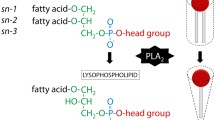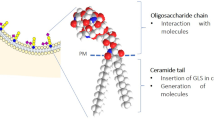Abstract
Glycosphingolipids (GSLs) are predominantly found in the outer leaflet of the plasma membrane, where they play a role in important processes such as cell adhesion, migration and signaling. However, by which mechanisms GSLs regulate these processes remains elusive. In this study, we therefore took advantage of the fact that some GSLs also serve as receptors for certain protein toxins, which rely on receptor binding for internalization and intoxication. Here, we demonstrate that Shiga and cholera toxins, which both possess multivalent GSL-binding capacity, induce dissociation of the cytosolic cPLA2α–AnxA1 complex in HeLa and HMEC-1 cells. The dissociation is mediated through an increase in cytosolic calcium levels and activation of the tyrosine kinase Syk. Ricin, a protein toxin that does not cross-link surface molecules, has no effect on the same complex. Importantly, we find that antibody-mediated cross-linking of Gb3 and GM1, the GSL receptors for Shiga and cholera toxin, respectively, also induces dissociation. These data demonstrate that cross-linking of GSLs at the plasma membrane mediates the intracellular signaling events resulting in dissociation of the complex. After dissociation, cPLA2α and AnxA1 are translocated to intracellular membranes where they are known to function in regulating membrane transport processes. In conclusion, we have characterized a novel mechanism for cell surface-induced initiation of intracellular signaling and transport events.






Similar content being viewed by others
References
van Meer G, Voelker DR, Feigenson GW (2008) Membrane lipids: where they are and how they behave. Nat Rev Mol Cell Biol 9:112–124
D’Angelo G, Capasso S, Sticco L, Russo D (2013) Glycosphingolipids: synthesis and functions. FEBS J 280:6338–6353
Simons K, Sampaio JL (2011) Membrane organization and lipid rafts. Cold Spring Harb Perspect Biol 3:a004697
Suzuki KG (2012) Lipid rafts generate digital-like signal transduction in cell plasma membranes. Biotechnol J 7:753–761
Furukawa K, Tokuda N, Okuda T, Tajima O, Furukawa K (2004) Glycosphingolipids in engineered mice: insights into function. Semin Cell Dev Biol 15:389–396
Proia RL (2003) Glycosphingolipid functions: insights from engineered mouse models. Philos Trans R Soc Lond B Biol Sci 358:879–883
Engedal N, Skotland T, Torgersen ML, Sandvig K (2011) Shiga toxin and its use in targeted cancer therapy and imaging. Microb Biotechnol 4:32–46
Hakomori S, Zhang Y (1997) Glycosphingolipid antigens and cancer therapy. Chem Biol 4:97–104
Kolter T (2011) A view on sphingolipids and disease. Chem Phys Lipids 164:590–606
Bergan J, Dyve Lingelem AB, Simm R, Skotland T, Sandvig K (2012) Shiga toxins. Toxicon 60:1085–1107
Sandvig K, Bergan J, Kavaliauskiene S, Skotland T (2014) Lipid requirements for entry of protein toxins into cells. Prog Lipid Res 54:1–13
Tcatchoff L, Andersson S, Utskarpen A, Klokk TI, Skanland SS, Pust S, Gerke V, Sandvig K (2012) Annexin A1 and A2: roles in retrograde trafficking of Shiga toxin. PLoS One 7:e40429
Gerke V, Creutz CE, Moss SE (2005) Annexins: linking Ca2+ signalling to membrane dynamics. Nat Rev Mol Cell Biol 6:449–461
Burke JE, Dennis EA (2009) Phospholipase A2 structure/function, mechanism, and signaling. J Lipid Res 50(Suppl):S237–S242
San Pietro E, Capestrano M, Polishchuk EV, DiPentima A, Trucco A, Zizza P, Mariggio S, Pulvirenti T, Sallese M, Tete S, Mironov AA, Leslie CC, Corda D, Luini A, Polishchuk RS (2009) Group IV phospholipase A(2)α controls the formation of inter-cisternal continuities involved in intra-Golgi transport. PLoS Biol 7:e1000194
Evans JH, Spencer DM, Zweifach A, Leslie CC (2001) Intracellular calcium signals regulating cytosolic phospholipase A2 translocation to internal membranes. J Biol Chem 276:30150–30160
Evans JH, Leslie CC (2004) The cytosolic phospholipase A2 catalytic domain modulates association and residence time at Golgi membranes. J Biol Chem 279:6005–6016
Grewal S, Ponnambalam S, Walker JH (2003) Association of cPLA2α and COX-1 with the Golgi apparatus of A549 human lung epithelial cells. J Cell Sci 116:2303–2310
Lauvrak SU, Walchli S, Iversen TG, Slagsvold HH, Torgersen ML, Spilsberg B, Sandvig K (2006) Shiga toxin regulates its entry in a Syk-dependent manner. Mol Biol Cell 17:1096–1109
Kvalvaag AS, Pust S, Sundet KI, Engedal N, Simm R, Sandvig K (2013) The ERM proteins ezrin and moesin regulate retrograde Shiga toxin transport. Traffic 14:839–852
Rapak A, Falnes PO, Olsnes S (1997) Retrograde transport of mutant ricin to the endoplasmic reticulum with subsequent translocation to cytosol. Proc Natl Acad Sci U S A 94:3783–3788
Lingwood CA, Law H, Richardson S, Petric M, Brunton JL, De GS, Karmali M (1987) Glycolipid binding of purified and recombinant Escherichia coli produced verotoxin in vitro. J Biol Chem 262:8834–8839
Sandvig K, Torgersen ML, Engedal N, Skotland T, Iversen TG (2010) Protein toxins from plants and bacteria: probes for intracellular transport and tools in medicine. FEBS Lett 584:2626–2634
Wernick NL, Chinnapen DJ, Cho JA, Lencer WI (2010) Cholera toxin: an intracellular journey into the cytosol by way of the endoplasmic reticulum. Toxins (Basel) 2:310–325
Ahmad N, Gabius HJ, Andre S, Kaltner H, Sabesan S, Roy R, Liu B, Macaluso F, Brewer CF (2004) Galectin-3 precipitates as a pentamer with synthetic multivalent carbohydrates and forms heterogeneous cross-linked complexes. J Biol Chem 279:10841–10847
Lepur A, Salomonsson E, Nilsson UJ, Leffler H (2012) Ligand induced galectin-3 protein self-association. J Biol Chem 287:21751–21756
Collins PM, Bum-Erdene K, Yu X, Blanchard H (2014) Galectin-3 interactions with glycosphingolipids. J Mol Biol 426:1439–1451
Katagiri YU, Mori T, Nakajima H, Katagiri C, Taguchi T, Takeda T, Kiyokawa N, Fujimoto J (1999) Activation of Src family kinase yes induced by Shiga toxin binding to globotriaosyl ceramide (Gb3/CD77) in low density, detergent-insoluble microdomains. J Biol Chem 274:35278–35282
Mori T, Kiyokawa N, Katagiri YU, Taguchi T, Suzuki T, Sekino T, Sato N, Ohmi K, Nakajima H, Takeda T, Fujimoto J (2000) Globotriaosyl ceramide (CD77/Gb3) in the glycolipid-enriched membrane domain participates in B-cell receptor-mediated apoptosis by regulating lyn kinase activity in human B cells. Exp Hematol 28:1260–1268
Walchli S, Skånland SS, Gregers TF, Lauvrak SU, Torgersen ML, Ying M, Kuroda S, Maturana A, Sandvig K (2008) The Mitogen-activated protein kinase p38 links Shiga Toxin-dependent signaling and trafficking. Mol Biol Cell 19:95–104
Torgersen ML, Walchli S, Grimmer S, Skånland SS, Sandvig K (2007) Protein kinase Cδ is activated by Shiga toxin and regulates its transport. J Biol Chem 282:16317–16328
Utskarpen A, Massol R, van DB, Lauvrak SU, Kirchhausen T, Sandvig K (2010) Shiga toxin increases formation of clathrin-coated pits through Syk kinase. PLoS One 5:e10944
Walchli S, Aasheim HC, Skånland SS, Spilsberg B, Torgersen ML, Rosendal KR, Sandvig K (2009) Characterization of clathrin and Syk interaction upon Shiga toxin binding. Cell Signal 21:1161–1168
Mocsai A, Ruland J, Tybulewicz VL (2010) The SYK tyrosine kinase: a crucial player in diverse biological functions. Nat Rev Immunol 10:387–402
Piotrowska H, Kucinska M, Murias M (2012) Biological activity of piceatannol: leaving the shadow of resveratrol. Mutat Res 750:60–82
Nijjar JS, Tindell A, McInnes IB, Siebert S (2013) Inhibition of spleen tyrosine kinase in the treatment of rheumatoid arthritis. Rheumatology (Oxford) 52:1556–1562
Kim KM, Kim DK, Park YM, Kim CK, Na DS (1994) Annexin-I inhibits phospholipase A2 by specific interaction, not by substrate depletion. FEBS Lett 343:251–255
Liu F, Huang J, Sadler JE (2011) Shiga toxin (Stx)1B and Stx2B induce von Willebrand factor secretion from human umbilical vein endothelial cells through different signaling pathways. Blood 118:3392–3398
Dixon SJ, Stewart D, Grinstein S, Spiegel S (1987) Transmembrane signaling by the B subunit of cholera toxin: increased cytoplasmic free calcium in rat lymphocytes. J Cell Biol 105:1153–1161
Gouy H, Deterre P, Debre P, Bismuth G (1994) Cell calcium signaling via GM1 cell surface gangliosides in the human Jurkat T cell line. J Immunol 152:3271–3281
Sandvig K, Brown JE (1987) Ionic requirements for entry of Shiga toxin from Shigella dysenteriae 1 into cells. Infect Immun 55:298–303
Rajendran L, Simons K (2005) Lipid rafts and membrane dynamics. J Cell Sci 118:1099–1102
Windschiegl B, Orth A, Romer W, Berland L, Stechmann B, Bassereau P, Johannes L, Steinem C (2009) Lipid reorganization induced by Shiga toxin clustering on planar membranes. PLoS One 4:e6238
Hammond AT, Heberle FA, Baumgart T, Holowka D, Baird B, Feigenson GW (2005) Crosslinking a lipid raft component triggers liquid ordered-liquid disordered phase separation in model plasma membranes. Proc Natl Acad Sci USA 102:6320–6325
Day CA, Kenworthy AK (2012) Mechanisms underlying the confined diffusion of cholera toxin B-subunit in intact cell membranes. PLoS One 7:e34923
Merritt EA, Sarfaty S, Van den Akker F, L’Hoir C, Martial JA, Hol WG (1994) Crystal structure of cholera toxin B-pentamer bound to receptor GM1 pentasaccharide. Protein Sci 3:166–175
Pani B, Singh BB (2009) Lipid rafts/caveolae as microdomains of calcium signaling. Cell Calcium 45:625–633
Renard HF, Simunovic M, Lemiere J, Boucrot E, Garcia-Castillo MD, Arumugam S, Chambon V, Lamaze C, Wunder C, Kenworthy AK, Schmidt AA, McMahon HT, Sykes C, Bassereau P, Johannes L (2015) Endophilin-A2 functions in membrane scission in clathrin-independent endocytosis. Nature 517:493–496
Romer W, Berland L, Chambon V, Gaus K, Windschiegl B, Tenza D, Aly MR, Fraisier V, Florent JC, Perrais D, Lamaze C, Raposo G, Steinem C, Sens P, Bassereau P, Johannes L (2007) Shiga toxin induces tubular membrane invaginations for its uptake into cells. Nature 450:670–675
Romer W, Pontani LL, Sorre B, Rentero C, Berland L, Chambon V, Lamaze C, Bassereau P, Sykes C, Gaus K, Johannes L (2010) Actin dynamics drive membrane reorganization and scission in clathrin-independent endocytosis. Cell 140:540–553
Rydell GE, Renard HF, Garcia-Castillo MD, Dingli F, Loew D, Lamaze C, Romer W, Johannes L (2014) Rab12 localizes to Shiga toxin-induced plasma membrane invaginations and controls toxin transport. Traffic 15:772–787
Safouane M, Berland L, Callan-Jones A, Sorre B, Romer W, Johannes L, Toombes GE, Bassereau P (2010) Lipid cosorting mediated by shiga toxin induced tubulation. Traffic 11:1519–1529
Boucrot E, Ferreira AP, Almeida-Souza L, Debard S, Vallis Y, Howard G, Bertot L, Sauvonnet N, McMahon HT (2015) Endophilin marks and controls a clathrin-independent endocytic pathway. Nature 517:460–465
Lakshminarayan R, Wunder C, Becken U, Howes MT, Benzing C, Arumugam S, Sales S, Ariotti N, Chambon V, Lamaze C, Loew D, Shevchenko A, Gaus K, Parton RG, Johannes L (2014) Galectin-3 drives glycosphingolipid-dependent biogenesis of clathrin-independent carriers. Nat Cell Biol 16:595–606
Herbert SP, Odell AF, Ponnambalam S, Walker JH (2007) The confluence-dependent interaction of cytosolic phospholipase A2α with annexin A1 regulates endothelial cell prostaglandin E2 generation. J Biol Chem 282:34468–34478
Kim SW, Rhee HJ, Ko J, Kim YJ, Kim HG, Yang JM, Choi EC, Na DS (2001) Inhibition of cytosolic phospholipase A2 by annexin I. Specific interaction model and mapping of the interaction site. J Biol Chem 276:15712–15719
Oh J, Rhee HJ, Kim S, Kim SB, You H, Kim JH, Na DS (2000) Annexin-I inhibits PMA-induced c-fos SRE activation by suppressing cytosolic phospholipase A2 signal. FEBS Lett 477:244–248
Brown WJ, Chambers K, Doody A (2003) Phospholipase A2 (PLA2) enzymes in membrane trafficking: mediators of membrane shape and function. Traffic 4:214–221
Rescher U, Zobiack N, Gerke V (2000) Intact Ca2+-binding sites are required for targeting of annexin 1 to endosomal membranes in living HeLa cells. J Cell Sci 113(Pt 22):3931–3938
Acknowledgments
We thank Anne Engen for excellent assistance with cell culturing, Anne-Mari Gjestvang Pedersen and Roger Simm for purification of Shiga toxins, and Maria Lyngaas Torgersen and Sascha Pust for critically reading the manuscript. This work was supported by grants from the South-Eastern Norway Regional Health Authority, the Norwegian Cancer Society and the Norwegian Research Council through its Centres of Excellence funding scheme, project number 179571.
Author information
Authors and Affiliations
Corresponding author
Electronic supplementary material
Below is the link to the electronic supplementary material.
Rights and permissions
About this article
Cite this article
Klokk, T.I., Kavaliauskiene, S. & Sandvig, K. Cross-linking of glycosphingolipids at the plasma membrane: consequences for intracellular signaling and traffic. Cell. Mol. Life Sci. 73, 1301–1316 (2016). https://doi.org/10.1007/s00018-015-2049-1
Received:
Revised:
Accepted:
Published:
Issue Date:
DOI: https://doi.org/10.1007/s00018-015-2049-1




